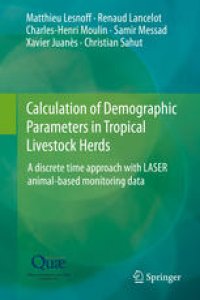
Ebook: Calculation of Demographic Parameters in Tropical Livestock Herds: A discrete time approach with LASER animal-based monitoring data
- Tags: Zoology, Animal Systematics/Taxonomy/Biogeography, Environmental Monitoring/Analysis, Animal Ecology
- Year: 2014
- Publisher: Springer Netherlands
- Edition: 1
- Language: English
- pdf
Having indicators to assess the effect of zootechnical, sanitary, economic or political intervention or the impact of environmental risks makes it possible to draw up strategies for improving domestic animal populations. This handbook is a compilation of the main concepts relating to the definition and calculation of demographic rates for largely non-intensive tropical animal farms. It is intended to be educational, and should help students, technicians, engineers, researchers and development staff to understand the definitions and formulas encountered in the literature more clearly and make them more self-sufficient in terms of analyses.
Ruminant livestock (cattle, small ruminants, and camels) have a determinant economic role in many tropical developing countries. In traditional low-input farming systems, demographic parameters (e.g. reproduction or mortality rates) are important indicators for estimating and modelling herd dynamics and production, and impacts of farming practices or environmental risks (droughts, epizootics, etc.). Although such parameters have been extensively described in the literature on tropical livestock, many descriptions only rely on empirical presentations of formulas without clear methodological justifications. This book fills this gap, presenting the main concepts used to define and compute demographic parameters for tropical livestock, such as probabilities and hazard rates of occurrences and competing risks. It is based on the LASER software, a relational database management system specifically designed for animal-based monitoring surveys. It also provides an introduction on R, the free statistical software (http://www.r-project.org) used for the computations.
It is intended for researchers, engineers, technicians, or students dealing with demographic parameters of tropical ruminant livestock in various fields such as animal science, epidemiology, or economy. It will also be valuable for readers wishing to enhance their understanding of definitions and formulas found in the literature, and it will guide them in their applications.